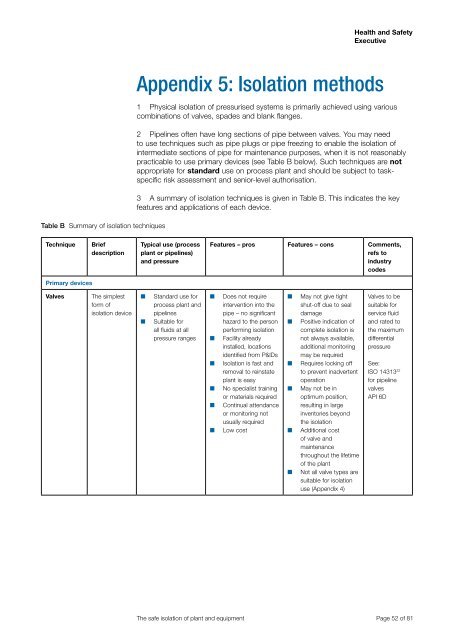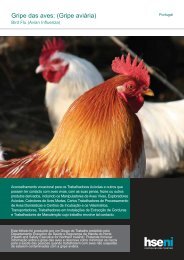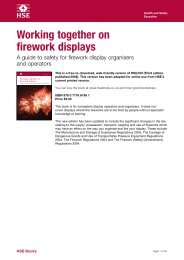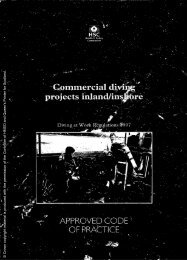The safe isolation of plant and equipment (HSG253) - Health and ...
The safe isolation of plant and equipment (HSG253) - Health and ...
The safe isolation of plant and equipment (HSG253) - Health and ...
Create successful ePaper yourself
Turn your PDF publications into a flip-book with our unique Google optimized e-Paper software.
Table B Summary <strong>of</strong> <strong>isolation</strong> techniques<br />
Technique Brief<br />
description<br />
Primary devices<br />
Valves <strong>The</strong> simplest<br />
form <strong>of</strong><br />
<strong>isolation</strong> device<br />
<strong>Health</strong> <strong>and</strong> Safety<br />
Executive<br />
Appendix 5: Isolation methods<br />
1 Physical <strong>isolation</strong> <strong>of</strong> pressurised systems is primarily achieved using various<br />
combinations <strong>of</strong> valves, spades <strong>and</strong> blank flanges.<br />
2 Pipelines <strong>of</strong>ten have long sections <strong>of</strong> pipe between valves. You may need<br />
to use techniques such as pipe plugs or pipe freezing to enable the <strong>isolation</strong> <strong>of</strong><br />
intermediate sections <strong>of</strong> pipe for maintenance purposes, when it is not reasonably<br />
practicable to use primary devices (see Table B below). Such techniques are not<br />
appropriate for st<strong>and</strong>ard use on process <strong>plant</strong> <strong>and</strong> should be subject to taskspecific<br />
risk assessment <strong>and</strong> senior-level authorisation.<br />
3 A summary <strong>of</strong> <strong>isolation</strong> techniques is given in Table B. This indicates the key<br />
features <strong>and</strong> applications <strong>of</strong> each device.<br />
Typical use (process<br />
<strong>plant</strong> or pipelines)<br />
<strong>and</strong> pressure<br />
■<br />
■<br />
St<strong>and</strong>ard use for<br />
process <strong>plant</strong> <strong>and</strong><br />
pipelines<br />
Suitable for<br />
all fluids at all<br />
pressure ranges<br />
Features – pros Features – cons Comments,<br />
refs to<br />
industry<br />
codes<br />
■<br />
■<br />
■<br />
■<br />
■<br />
■<br />
Does not require<br />
intervention into the<br />
pipe – no significant<br />
hazard to the person<br />
performing <strong>isolation</strong><br />
Facility already<br />
installed, locations<br />
identified from P&IDs<br />
Isolation is fast <strong>and</strong><br />
removal to reinstate<br />
<strong>plant</strong> is easy<br />
No specialist training<br />
or materials required<br />
Continual attendance<br />
or monitoring not<br />
usually required<br />
Low cost<br />
May not give tight<br />
shut-<strong>of</strong>f due to seal<br />
damage<br />
Positive indication <strong>of</strong><br />
complete <strong>isolation</strong> is<br />
not always available,<br />
additional monitoring<br />
may be required<br />
Requires locking <strong>of</strong>f<br />
to prevent inadvertent<br />
operation<br />
May not be in<br />
optimum position,<br />
resulting in large<br />
inventories beyond<br />
the <strong>isolation</strong><br />
Additional cost<br />
<strong>of</strong> valve <strong>and</strong><br />
maintenance<br />
throughout the lifetime<br />
<strong>of</strong> the <strong>plant</strong><br />
Not all valve types are<br />
suitable for <strong>isolation</strong><br />
use (Appendix 4)<br />
<strong>The</strong> <strong>safe</strong> <strong>isolation</strong> <strong>of</strong> <strong>plant</strong> <strong>and</strong> <strong>equipment</strong> Page 52 <strong>of</strong> 81<br />
■<br />
■<br />
■<br />
■<br />
■<br />
■<br />
Valves to be<br />
suitable for<br />
service fluid<br />
<strong>and</strong> rated to<br />
the maximum<br />
differential<br />
pressure<br />
See:<br />
ISO 14313 22<br />
for pipeline<br />
valves<br />
API 6D







